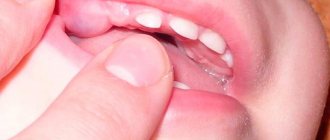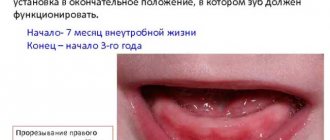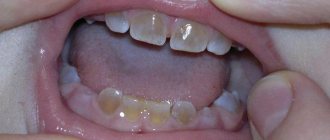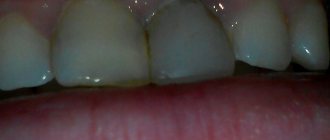What do the deadlines depend on?
When determining why a child’s teeth do not grow, you need to take into account the following factors:
- the formation process depends on gender, girls develop teeth earlier than boys;
- The baby's growth also affects teething. So, if the baby is not tall, then teething will begin later;
- upper and lower jaws. At what stage does teething occur earlier? On the bottom.
A child’s bite has two stages – temporary and permanent. If it is temporary, then teething occurs less frequently. The location of the teeth also matters, for example, the second and third molars emerge later than the others. It is influenced by development and climate, place of residence, heredity - when the parents began to teethe, their children will begin to do so at about the same age.
Molars in children: symptoms of eruption
In almost all children, molars appear painlessly and unnoticeably. However, there are exceptions when the growth of permanent teeth is accompanied by unpleasant sensations. A common symptom when teething is increased temperature, up to 38 ºС. The child also complains of:
- weakness and drowsiness due to decreased immunity;
- runny nose, excessive salivation;
- inflammation of the gums;
- itching, pain while eating.
Massaging your gums will help relieve discomfort in your mouth. To relieve inflammation, use dental gel. Important: Disinfect your hands or wear sterile gloves before applying.
Consult your dentist before purchasing medications. Severe inflammation is a signal that teeth are not growing properly. Without treatment, the child's bite may become deformed.
Complications during teething
- bite defects. Molars are larger in size than baby teeth; there may not be enough space in a narrow jaw. The bite changes if the baby teeth do not fall out, but new ones begin to grow.
- hyperdentia – teeth grow in a second row. This happens for various reasons, most often - the baby tooth holds tightly and the root one looks for other ways.
- teeth don't grow. If the milk one falls out, but the permanent one is delayed for six months, you need to consult a doctor. Poor dental growth is one of the signs of problems with the immune system in children.
- caries and pulpitis. The first sign of enamel destruction is the child’s complaints of a sore throat, sweet and hot foods “getting” into the tooth. If pulpitis affects the molars, children’s body temperature rises and severe pain appears. Then treatment of pulpitis is urgently needed without delay.
Is late tooth growth dangerous?
If baby teeth do not grow, then in general this does not pose a danger, but it cannot be done without the intervention of a doctor. The specialist must conduct a preventive examination, talk with the parents, determining their teething characteristics, and then determine whether there is a reason for concern or not. Studies have shown that if the cause is heredity, then problems with permanent teeth are possible in the future.
What causes late eruption:
- health problems with the mother during pregnancy (for example, severe toxicosis);
- various diseases.
Incorrect placement of primary teeth affects the location of permanent teeth.
A child’s teeth deteriorate: reasons
The most common problems with children's teeth identified by dentists are:
- the baby’s teeth turn black or the enamel darkens in places;
- the child has fragile teeth, which is why they begin to crumble;
- active development of caries in preschool children.
Let's look at the causes of these key problems and possible ways to solve them.
A child's teeth deteriorate for various reasons. The main ones:
- exposure to aggravating factors during the period of intrauterine development of the fetus (severe and prolonged toxicosis during pregnancy, impaired or insufficient nutrition of the expectant mother, necessary or careless use of certain medications);
- if a baby under the age of one year was given intensive antibiotic therapy;
- insufficient dental care and, as a consequence, the development of early caries;
- insufficient absorption of calcium;
- permanent and persistent dental plaque;
- hereditary predisposition (individual characteristics of enamel);
- limited salivation;
- chronic diseases. For example, gastritis with high acidity makes tooth enamel more susceptible to caries. This is explained by the fact that increased acidity affects the absorption of calcium and phosphorus;
- dysbacteriosis;
- the presence of a large amount of foods and drinks containing sugar in the child’s diet;
- impaired metabolism;
- exchange of bacteria between parents and child (for example, when sharing cutlery);
- unformed children's enamel.
Dark spots on the enamel may indicate that caries has begun to develop. If you start this process, caries will penetrate even deeper into the tooth. Due to the special structure of the pulp, destructive processes spread very quickly: for example, caries can turn into pulpitis in just a few months.
Consequences of a double smile
Parents should not fall into a state of panic when they see an additional “element” in the child’s mouth. Double dentition is a solvable problem. The main thing is to get an appointment with the dentist on time.
If you put off dental treatment for a long time, you may encounter:
- Impaired diction. Curved incisors and fangs interfere with the pronunciation of many sounds and make the baby’s speech unclear. Correcting sound pronunciation takes a lot of time and requires qualified help from a speech therapist.
- Difficulties in chewing food. The patient is uncomfortable biting into hard foods. In the process of chewing them, small food debris gets clogged into the spaces between the “shark neighbors.” This causes severe discomfort. Cleaning between teeth takes time and effort. Small children cannot carry out this hygienic procedure at the proper level on their own. This means that the risk of tooth decay increases dramatically.
- Diseases of the gastrointestinal tract. Having difficulty biting and chewing food, some children begin to swallow food almost entirely. As a result, the load placed on the gastrointestinal tract increases. Gastritis or other gastric pathologies may develop.
- Weight loss. The complication is also the result of improper chewing of food. The child swallows large pieces and large amounts of air. Because of this, it becomes saturated ahead of time. This has a negative impact on weight gain.
- Inflammation of the gums. It is difficult to clean the interdental area from food debris and plaque as efficiently as possible. Accumulations of food put pressure on the gums and irritate them. The inflammatory process is aggravated by pathogenic microorganisms that actively multiply in plaque.
All these consequences of a “shark” smile are unpleasant and pose a health threat. Therefore, it is unacceptable to ignore the presence of a dental problem in a child.
Content:
- Reasons for violation
- What are shark teeth
- Consequences of a shark smile
- When is urgent dental care indicated?
- Treatment
If a baby tooth falls out, but the root remains, the situation is clear - it is necessary to remove bone fragments from the soft tissue so that they do not cause an inflammatory process.
There is no need to be afraid of the treatment procedure, since it is performed under local anesthesia, which means it will not cause acute pain in the little patient. It is more difficult for parents to make a decision if the molar has come out, but the milk tooth has not fallen out. How to act correctly? After all, for obvious reasons, loving mothers and fathers don’t really want to take their baby to an appointment with a dental surgeon. There is always hope that a complete change of the primary milk unit will occur naturally. We propose to look into this problem in detail.
Is late teething dangerous?
In addition to parents who consider late teething a warning sign, there are others who tend to believe that the later baby teeth appear, the healthier they will be. This is a common myth that has not been supported by science, so you should not believe it.
Too early or late teething or their appearance in an atypical order (outside the pattern) is a reason to see a doctor. Most likely, a diagnosis will be prescribed that will help identify the cause of this developmental feature.
The danger of late teething lies only in possible diseases that occur unnoticed by parents. If experts find out that the reasons for late teething are related to heredity, lack of calcium or vitamin D, there is nothing dangerous about it. In this case, tooth growth is stimulated by changing the diet or prescribing vitamin complexes.
The main thing is for parents to contact a specialist in time to identify a possible disease and treat it as soon as possible.
What are shark teeth?
They are talked about when extra units appear in the dentition, that is, a child’s tooth has not had time to fall out, but a molar has already appeared next to it. Then the smile seems strange and looks unaesthetic.
What to do with such a problem? Does she tolerate delays? You can wait no longer than two to three months for the milk root to resolve on its own. During this time, you can try to loosen the extra unit. If the time has come to an end, but the “shark” bite remains, you need to go to the dental clinic. Some parents wait longer, and their situation is resolved in the most favorable way. But such tactics are dangerous.
The fact is that a long stay of the root structure in an incorrect position can lead to malocclusions , which will persist into adulthood. It is important to consider where the “shark neighbors” are. If we are talking about the smile zone, then delay is definitely unacceptable.
Reasons for violation
There are many reasons why teeth fall out late
- Deficiency of chewing load. Modern parents try to protect their children from any difficulties, including prolonged chewing of solid food. They grind soups, meat, vegetables and even fruits in a blender - as long as the child eats. You can't do that. The chewing load should be adequate for age. Otherwise, temporary roots will be reabsorbed with a delay.
- The presence of dense scars on the gums. They are formed if, in the first year of life, the child has undergone surgery on the tissues of the oral cavity, suffered a serious injury or burn of the gums. Scars are formed by very dense connective tissue. Because of this, the process of changing the bite may not proceed correctly.
- Incomplete resorption of the temporary root. This is not a pathological condition, but a physiological feature. But you need to understand that if a tooth is removed at the wrong time, its replacement will erupt in an atypical place. This may be a reason to wear braces in the future.
- Dystopia. A situation where the root rudiment was located in a non-standard place for it. Why this happened cannot be said. Doctors explain the problem by the uniqueness of a particular child’s body. The dentist decides what to do in such a situation after examining the x-rays. In some cases, it is possible to “pull” the crooked unit into the correct position. If this is not possible, you need to constantly monitor the crooked tooth, as it may pose a danger to its neighbors (put pressure on their crown or roots).
My parents won’t be able to figure out on their own why the tooth came out but the baby tooth hasn’t fallen out yet. Therefore, amateur performance is unacceptable. The smartest thing to do is make an appointment with a doctor.











